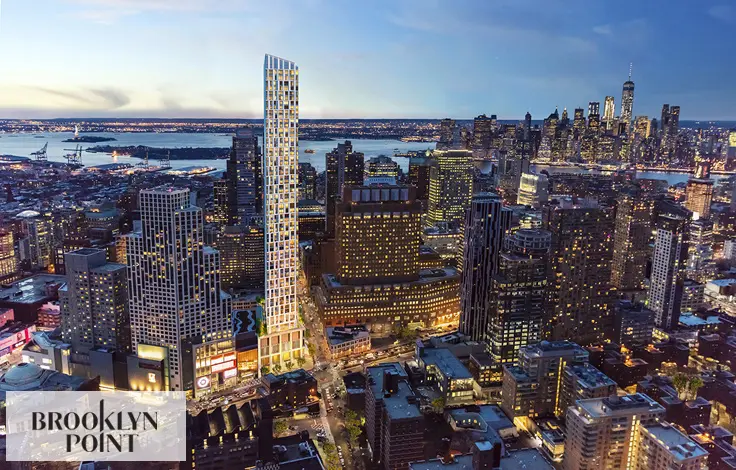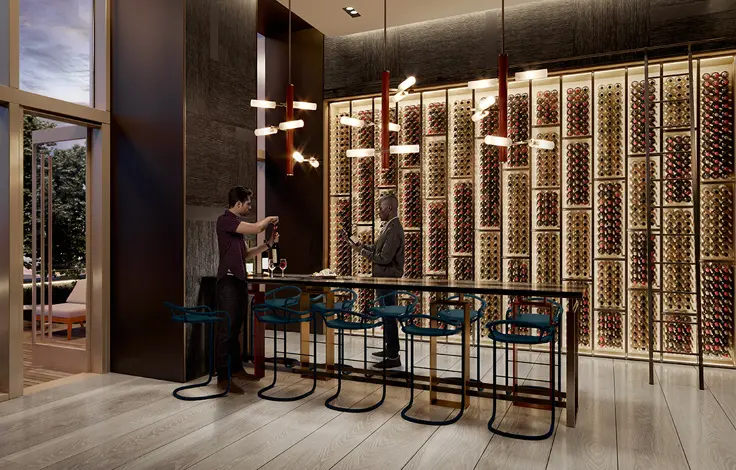 Carter Horsley
Carter HorsleyDec 23, 2011
Carter's Review
This 40-story apartment tower at 400 East 56th Street was one of the tallest in the Sutton Place area when it was erected in 1968 with 628 rental apartments.
It is known as Plaza 400 and was converted to co-operative apartments in 1981 and now has 581 apartments. It is also known as 401-415 East 55th Street and 1006-1020 First Avenue.
It was designed by Philip Birnbaum and Associates for Bertram F. Bonner.
Bottom Line
Occupying less than 40 percent of its large site, this “Maltese Cross”-shaped tower has many balconies, a roof-top swimming pool, and very impressive lush landscaping
Description
With a driveway and a large lobby with a large chandelier reported order by the Nizam of Hyderabad, India, in the 1840s, this large tower, covered with white brick speckled with bronze, rises without setbacks from its own plaza but its plan makes it considerably more interesting than most sheer towers. Its mass is also enlivened by its angled balconies and it has a polished red-granite base and discrete air-conditioners.
The building has a large fountain outside its entrance and there are shops in the middle of the site’s First Avenue frontage.
With an appropriately impressive, two-story-high lobby for a building of this size, the Plaza 400 has an excellent location that is a bit removed from the bustle of the Ed Koch Queensboro Bridge but very close to the charming gardens and parks of Sutton Place and the neighborhood's many restaurants. The lobby was designed by Raymond Loewy and William Snaith Inc.
About 60 percent of the units have balconies.
Amenities
The building has a 24-hour doorman, a concierge, roof-top health club with swimming pool, a fitness center, a children’s playroom, a bicycle room, an attended, 24-hour garage, a package room, a laundry room and a resident superintendent.
Apartments
Apartment 12N is a three-bedroom unit with an 11-foot-wide entry foyer that opens onto a 23-foot-long living room with a 60-square-foot balcony and adjoins 14-foot-long dining alcove next to an 11-foot-long, eat-in kitchen.
Apartment 22N is a three-bedroom unit with a 23-foot-ong living room with a 10-foot-wide balcony and a 13-foot-wide dining alcove next to a 10-foot-wide kitchen with sliding doors.
Apartment R on the 4th through the 40th floor is a two-bedroom unit with a wide entry foyer that opens onto a 31-foot-long living room with a 13-foot-wide balcony and an 11-foot-wide enclosed and windowed kitchen.
Apartment 12LM is a two-bedroom unit with a 33-foot-long living room with a balcony, a 16-foot-long dining room next to a 7-foot-long kitchen, a 17-foot-long study and a 28-foot-long family room.
Apartment 25D is a two-bedroom unit with a 15-foot-long entry foyer that opens onto a 26-foot-long living room with and angled balcony and a 14-foot-long dining alcove adjacent to a 11-foot-wide, pass-through kitchen.
Apartment 19B is a two-bedroom unit with a 10-foot-wide, entry foyer that opens onto a 26-foot-long living room with a 12-foot-wide balcony and a 14-foot-long dining alcove next to an 11-foot-wide, windowed kitchen.
Apartment 37K is a one-bedroom unit with a 29-foot-long living room with an 11-foot-long alcove, and an enclosed 10-foot-long kitchen.
Apartment 35S is a one-bedroom unit with a 9-foot-entry foyer and a 21-foot-long living room and an 8-foot-long kitchen.
History
The building was one of the first to take advantage of the city’s 1961 Zoning Resolution that granted developers bonuses for providing plazas and it became the city’s second tallest residential tower after the 47-story Excelsior apartment building on 57th Street and Second Avenue was erected in 1967.
An August 13, 1967 article by Arnold H. Lubasch in The New York Times discussed the site’s history, noting that “the earliest known record of the property, discovered in a title search years ago, noted the 1767 sale of 12 acres “beginning at a walnut tree on the Post Road in the outwards of New York.”
“This original property,” the article continued, “embracing the entire block between First Avenue and Sutton Place South from 55th to 56th Streets, passed in the 18th Century to Thomas Buchanan, whose heirs sold it in 1856 to Peter Doelger. He used the site for a famous brewery and for his private home. He died in 1912, leaving the property to his sons, Peter and Charles Doelger. A syndicated headed by Irving and Henry Chanin acquired title in 1930, but the Depression frustrated their plans for an apartment project, and the Doelgers took back the property in 1932. Although the Doelger brewery on the site closed in 1928, the massive brewery building on 55th Street continued to stand as a landmark until 1952, when it was demolished to make way for a one-story garage topped by the Town Tennis Club. Four apartment buildings were erected on the Sutton Place South and 56th Street sides of the block between 1949 and 1952. The property remained in the hands of a company headed by William E. P. Doelger, a grandson of the brewery founder.”
In 1979, American Invsco filed plans to convert the building to co-operatives with a total asking price of $101.5 million. According to a November 4, 1979 article in The New York Times by James Barron, the Chicago-based developer “paid $8.3 million last summer for the land beneath the tower” and refinanced the building’s mortgages, which now total more than $41 million.” The company, which was headed by Nicholas Gouletas, who immigrated from Greece with his parents as a youngster, also bought the apartment tower at 900 Park Avenue for conversion. Mr. Gouletas founded Invsco 10 years before with his brother, Victor, who has engineering and law degrees, and his sister, Evangeline, a graduate mathematician.
Mr. Barron’s article said that some tenants in the building said that the conversion plan was “undesirable because leaks have plagued the Plaza 400 since it opened…and also assert that their gas stoves are unreliable and that elevator service is slow.”
A March 18, 1980 article in The New York Times by Jeff Gerth said that American Invsco “usually acquires its properties with financing of 100 percent or more from banks and insurance companies,” adding that “in some instances, major lenders have granted the company loans of 120 percent or more at interest rates 2 percentage points or more above the prime lending rate to cover the purchase and conversion of a building. The company’s hard-sell tactics have polarized tenants of the buildings it has taken over, turning some into successful real estate speculators and leaving others homeless and bitter….Tenants who have lived in buildings purchased by American Invsco say renters are told that if they do not buy their apartments they will be out on the street.”
A February 8, 1985 article about American Invsco’s $147 million conversion of Continenetal Towers at 301 East 79th Street by Kirk Johnson in The New York Times said that Invsco, “founded by the family of Evangeline Gouletas Carey, the wife of former Gov. Hugh Carey, nearly collapsed in the 1982 recession.”

- Co-op built in 1968
- 4 apartments currently for sale ($599K to $1.799M)
- Located in Beekman/Sutton Place
- 591 total apartments 591 total apartments
- 10 recent sales ($529.7K to $985K)
- Doorman
- Pets not Allowed






 6sqft delivers the latest on real estate, architecture, and design, straight from New York City.
6sqft delivers the latest on real estate, architecture, and design, straight from New York City.
